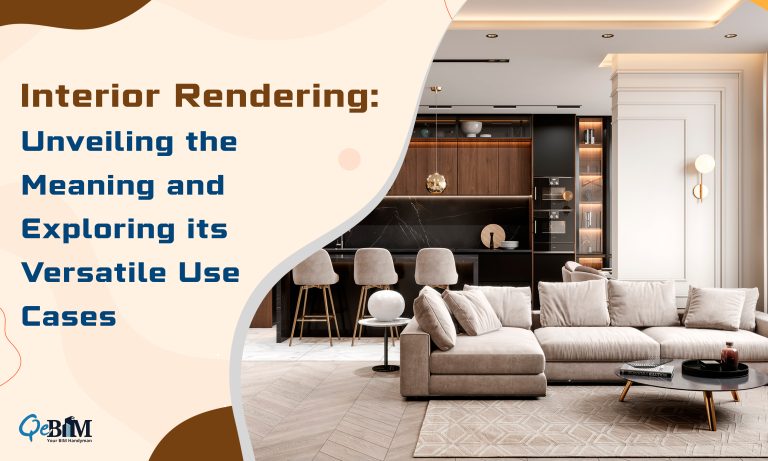Interior Rendering: Unveiling the Meaning and Exploring its Versatile Use Cases

Introduction
Visualizing thoughts and principles are increasingly essential in the rapidly changing fields of architecture and interior design. Interior Rendering is currently a potent tool for bringing ideas into being and enabling both customers and professionals to investigate and interact with concepts before they are implemented in everyday life. This blog article will examine what interior rendering is, why it’s important in architecture projects, and how it may be used in a variety of situations. So, let’s start a fascinating adventure into the interior rendering world.
Understanding Interior Rendering
Developing accurate, computer-generated images of inside rooms is a technique associated with interior rendering, commonly referred to as architectural rendering. It integrates a variety of components, including furniture, lighting, materials, textures, and substances, to accurately represent the design that is wanted. Interior renderings may accurately depict real-world situations using advanced 3D modelling as well as rendering technologies, allowing stakeholders to assess and improve their proposals. Ninety percent of interior designers utilize interior rendering in their professional endeavors, in accordance with recent research by the American Society of Interior Designers. Additionally, the research discovered that interior rendering might contribute to a 20% rise in revenue.
Types of Interior Rendering
The two primary forms of interior rendering include conceptual rendering as well as photorealistic rendering.
- The most popular interior rendering style includes photorealistic rendering. It produces photographs-like visuals using 3D computer graphics software. Interior designers frequently use renderings of this kind to present their ideas to customers.
- Conceptual rendering represents a less lifelike rendering style that conveys a design’s overarching vision. Architects frequently use it to demonstrate to customers how a project will appear before it is constructed.
Significance of Interior Rendering Services
- Enhanced Visualization and Communication
A tangible visual depiction of an architectural project is offered via interior rendering. Designers may successfully convey their ideas to consumers, financiers, and other stakeholders by exhibiting convincing and engrossing images. In addition to this, these drawings help people comprehend the design concept more appealing, helping them to make wise decisions throughout the project’s lifespan. - Time and Cost Efficiency
To visualize interior designs in earlier times, actual prototypes and mock-ups were frequently made, which led to higher costs and extended development periods. But Interior Rendering Services do away with the requirement for pricey real-world models. Within the virtual environment, modifications and variations may be done quickly and easily, conserving time and money tremendously. - Iterative Design Process
Interior visualization gives architects and interior designers the freedom to try new things and improve their concepts. Professionals may try several design possibilities, assess their visual effects, and adjust them appropriately with having the capacity to execute instantaneous adjustments. The general caliber of the finished design is improved by using an iterative process.
Cases of Interior Rendering
- Real Estate Marketing
The marketing of real estate properties depends heavily on interior rendering. High-quality drawings emphasize a property’s potential, accentuate its distinct selling characteristics, and captivate potential purchasers. Clients may see the area in these drawings and use them to envision the finished result and make selections. - Interior Design Planning
Interior design planning and idea visualization are made easier using interior rendering. Designers may evaluate the aesthetics and usefulness of their ideas before putting them into practice by correctly simulating color schemes, material finishes, furniture layouts, and lighting settings. In addition to this, this procedure makes sure that the final design meets the client’s requirements. - Architectural Presentations and Competitions
When presenting or competing in architectural contests, interior renderings are crucial. Dazzling renderings may help architects stand out from the competition and present their design concepts. The likelihood of landing contracts and partnerships is increased by having the capacity to offer a thorough and appealing visualization. - Collaborative Decision-Making
Coordination between designers, architects, building suppliers, and clientele is facilitated through interior renderings. All parties involved could engage with virtual tours, talk about design elements, and give input in real-time. This cooperative method promotes improved project comprehension and facilitates fluid decision-making.
Conclusion
The means by which architects and interior designers express their thoughts and opinions have been revolutionized by interior rendering. Professionals may produce engaging and accurate visualizations of interior environments by utilizing 3D visualization technologies. Services for interior rendering are important because they may improve communication, simplify the design procedure, and conserve time and money. Interior rendering is clearly here to stay, changing how we perceive and interact with interior design as the need for Architectural Rendering Services increases.